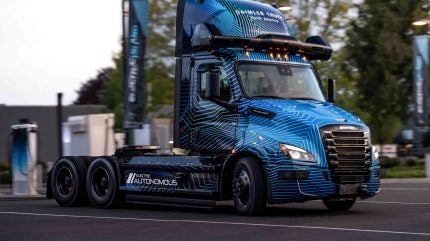
Daimler Truck has combined battery electric drive and integrated autonomous driving technology into one semi-truck for the first time: the autonomous Freightliner eCascadia technology demonstrator.
The truck is based on the production BEV model and has Torc’s autonomous driving software and Level 4 sensor and compute technology. This will eventually enable Level 4 autonomous driving.
Torc Robotics is Daimler Truck’s independent subsidiary for autonomous virtual driver technology. While still a research and advanced engineering project, the autonomous vehicle has the potential to evolve into a modular, scalable platform with different propulsion systems for flexible use in different applications. The goal is to offer customers a choice of the right vehicles for their specific business and transportation needs.
“By combining zero emission and autonomous technologies in one product, we are testing solutions for challenges our customers are likely to face in the future,” said John O’Leary, president and CEO of Daimler Truck North America.
Joanna Buttler, head of global autonomous technology group at Daimler Truck, added: “Together with Torc, we are making significant progress towards introducing autonomous trucks in the US by 2027. While we target autonomous trucks with conventional propulsion technology for this first market launch, we always look further into the future. We will employ an iterative approach to the development, testing and optimisation of autonomous-electric technology while exploring the most promising use cases in collaboration with our fleet customers.”
The BEv Freightliner eCascadia, a proven vehicle base for the autonomous technology demonstrator, went into production in 2022 and has now reached 6m real world miles in 55 fleets in the United States. This zero-emission Class 8 truck is designed to provide optimal productivity for fleets looking to switch to efficient, zero emission tractors. The battery can be recharged to 80% capacity in 90 minutes.
How well do you really know your competitors?
Access the most comprehensive Company Profiles on the market, powered by GlobalData. Save hours of research. Gain competitive edge.

Thank you!
Your download email will arrive shortly
Not ready to buy yet? Download a free sample
We are confident about the unique quality of our Company Profiles. However, we want you to make the most beneficial decision for your business, so we offer a free sample that you can download by submitting the below form
By GlobalDataSeveral battery and drive axle options are available, providing a typical range of 155, 220 or 230 miles, depending on the specific configuration. The eCascadia is equipped with the proprietary Detroit ePowertrain, which delivers performance, efficiency, and reliability and also comes standard with the Detroit Assurance suite of safety systems, including Active Brake Assist.
For the first time, the autonomous sensor suite and compute power, currently being tested on the autonomous diesel Cascadia, is packaged to fit the smaller day cab configuration of the BEV model. To ensure adequate cooling, engineers developed an advanced prototype air cooling concept for the compute stack which is positioned between the driver and passenger seats. Customised software provides the autonomous system with control interfaces and feedback on vehicle status. The in house designed sensor bar cover, which incorporates cameras, lidar sensors and radar sensors, improves aerodynamic performance while providing better protection from damage and soiling. Four additional 12 volt batteries provide enough high voltage power to ensure uninterrupted operation and increased efficiency and safety.
The autonomous eCascadia demonstrator provides a glimpse of future autonomous use cases, including shorter, repeatable routes with the use of zero emissions infrastructure. Depending on the application, future autonomous trucks could also be powered by hydrogen-based propulsion technology.
In the currently tested hub to hub application, the truck’s intent is to drive autonomously between freight centres along US highway corridors. By identifying synergies between zero emissions and autonomous infrastructure in a future scenario, the charging infrastructure and autonomous freight hubs could be combined to charge and load simultaneously, further enhancing efficiency for carriers.
The autonomous eCascadia technology demonstrator is designed with many commonalities with the production eCascadia, leveraging synergies in the development process, streamlining engineering processes and increasing customer value through ease of serviceability as customers may already be familiar with the BEV version.
Daimler Truck has been developing and testing autonomous truck technology since 2015 with the reveal of the Freightliner Inspiration Truck as the first licensed SAE Level 2 autonomous commercial truck to operate on open public highways in the US.
Torc has been testing autonomous ready Freightliner Cascadia trucks in real world applications with selected logistics companies such as Schneider and CR England, successfully moving customer freight autonomously on its test route between Phoenix and Oklahoma City, over the past year.
Daimler Truck expects autonomous trucking to generate revenues of EUR3bn and EBIT of EUR1bn as early as 2030.







